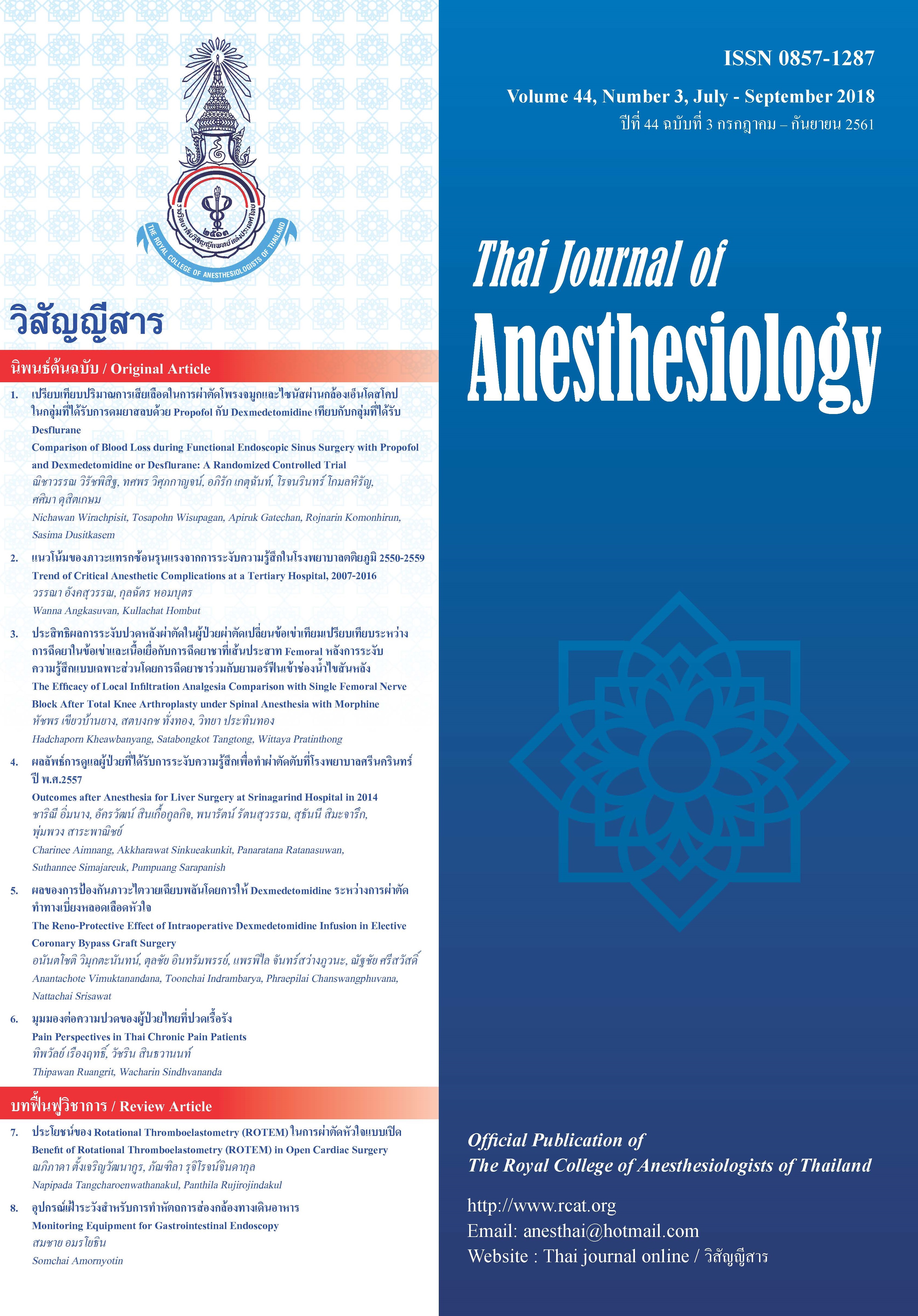Trend of Critical Anesthetic Complications at a Tertiary Hospital, 2007-2016
Main Article Content
Abstract
Objectives: To identify trend of critical anesthetic complications at tertiary hospital, compare to that reported by the Royal College of Anesthesiologists of Thailand (RCAT), describe level GHI and direct anesthetic related complications.
Methods: Annual reports (2007 to 2016) of anesthetic department at Hatyai hospital was retrospectively examined. The following data were collected: demographic data of anesthetic practices, top 3 of critical complications, death within 24 hours, cardiac arrest, awareness, difficult intubation and failed intubation yearly.
Results: The 156,725 anesthetic practices were examined. There had been increasing number of elderly patients, patients with ASA II and III, and those undergoing general anesthesia. There were 258 complications which the top 3 events being reintubation, pulmonary edema and cardiac arrest. The degree of severity was mostly as level F which led to prolonged hospital stay (43.9%). The incidents of death within 24 hours were highest in 2008 (31.91:10,000) and lowest in 2015 (11.95:10,000), while death on table and cardiac arrest remained unchanged. Difficult intubation had decreased markedly since 2013. Anesthetic practices undertaken after failed intubation were cancellation of the operations, changing techniques of anesthesia and using surgical airway. For awareness, 19 patients were reported that occurred in female, duringcesarean section and recall during incision or suture.
Conclusions: Trend of death within 24 hours and difficult intubation in anesthetic practices was in line with national trend reported by RCAT. Human factors and latent risk factors might have led to repeating events in 10 years.
Article Details
References
2. Charuluxananan S, Punjasawadwong Y. Perioperative and anesthetic adverse events in Thailand (PAAD Thai) incident reporting study:anesthetic profiles and outcomes. Asian Biomedicine 2017;11(1):21-32.
3. Guglielminotti J, Wong CA, Landau R, Li G. Temporal trends in anesthesia-related adverse events in cesarean deliveries, New York State, 2003-2012. Anesthesiology 2015;123(5): 1013-23.
4. Zeng LA, Ng SY, Thong SY. Analysis of critical incidents during anesthesia in a tertiary hospital. International Journal of Clinical Medicine 2016;7(5):320-33.
5. Forrey RA, Pedersen CA, Schneider PJ. Interrater agreement with a standard scheme for classifying medication errors. Am J Health Syst Pharm 2007;64(2):175-81.
6. Weinger MB, Slagle J, editors. Human factors research in anesthesia patient safety. Proceedings of the AMIA Symposium; 2001: American Medical Informatics Association 2002:58-63.
7. Sprung J, Warner ME, Contreras MG, et al. Predictors of survival following cardiac arrest in patients undergoing noncardiac surgery, a study of 518,294 patients at a tertiary referral center. Anesthesiology 2003;99(2):259-69.
8. Nunes JC, Braz JR, Oliveira TS, de Carvalho LR, Castiglia YM, Braz LG. Intraoperative and anesthesia-related cardiac arrest and its mortality in older patients: a 15-year survey in a tertiary teaching hospital 2014;9(8):e104041.
9. Braz LG, Modolo N, do Nascimento Jr P, et al. Perioperative cardiac arrest: a study of 53 718 anaesthetics over 9 yr from a Brazilian teaching hospital. Br J Anaesth 2006;96(5):569-75.
10. Charuluxananan S, Thienthong S, Rungreungvanich M, et al. Cardiac arrest after spinal anesthesia in Thailand: a prospective multicenter registry of 40,271 anesthetics. Anesth Analg 2008;107(5):1735-41.
11. Zuercher M, Ummenhofer W. Cardiac arrest during anesthesia. Current opinion in critical care 2008;14(3): 269-74.
12. Frerk C, Mitchell VS, McNarry AF, et al. Difficult Airway Society 2015 guidelines for management of unanticipated difficult intubation in adults†. Br J Anaesth 2015;115(6):827-48.
13. Kinsella S, Winton A, Mushambi M, et al. Failed tracheal intubation during obstetric general anaesthesia: a literature review. Int J Obstet Anesth 2015;24(4):356-74.
14. Akavipat P, Sookplung P, Premsamran P, Toomtong P, Kusumaphanyo C, Muansaiyart P. The Thai anesthesia incident monitoring study (Thai AIMS): an analysis of 21 awareness events. J Med Assoc Thai 2009;92(3):335-41.
15. Orser BA, Mazer CD, Baker AJ. Awareness during anesthesia. CMAJ 2008;178(2):185-8.
16. Van Beuzekom M, Boer F, Akerboom S, Hudson P. Patient safety: latent risk factors. Br J anaesth 2010;105(1):52-9.


